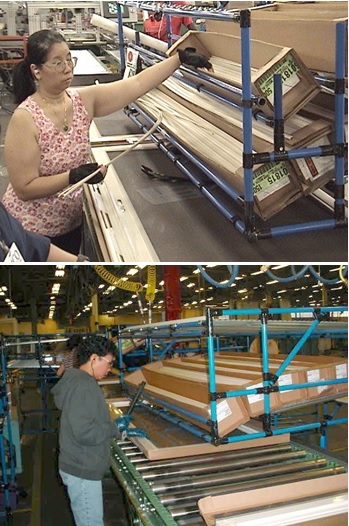Many lean thinkers ask how they can accelerate the pace of a transformation or spread it to other facilities. EMCO Enterprise’s Des Moines plant has an answer for both questions.
A relatively quick, intensive project accelerated the rate of improvement and created a showcase facility for spreading the new approach. “The project was designed to show that you don’t have to wait years and train people forever before seeing tangible results,” said Gary Berndt, senior vice president of manufacturing at parent Andersen Corporation.
Before the project, many EMCO employees had been through some lean manufacturing training and were applying the lessons in a nascent lean conversion, but Berndt described the effort as “putting a toe in the water. We wanted people to jump in.”
The new approach emphasized three tactics:
- Set aggressive goals. The EMCO plant was given a goal of improving productivity by 30% in eight weeks.
- Emphasize action by local plant managers and associates with the minimum training needed and limited involvement by outside lean experts. A team of four specialists from the parent company was assigned to the plant to assist the EMCO project team, which was co-led by Mike Dass, EMCO director of operations, and Daniel Hicks, Andersen’s manufacturing service director.
- Use data to identify and attack the top three to five problems. Focus efforts on solving a few problems and when these are done, move onto the next few.
The plant’s three assembly lines, which make aluminum and polypropylene storm doors, are high-mix and high-volume. A job shop is dedicated to making special, highly customized doors.
To satisfy demand from homeowners and the housing industry for ever-greater variety, EMCO introduced more high-volume door models, colors, and features in recent years. As it added new models to existing assembly lines, it required production changeovers from doors with lots of features and high labor content to standard models with fewer features and less labor content.
The project team, consisting of the plant’s director of operations, plant industrial engineers, quality engineers, logistics manager, maintenance supervisor, scheduling and production supervisors, production manager, and Andersen lean experts, decided to focus on the main assembly line, which would have a positive impact on the profitability of the plant.
The project management methodology was simple:
- Ten-minute, stand-up meetings were held at 8:30 a.m. after the start of first shift and at 3:30 p.m. after the start of second shift to exchange information about problems and related countermeasures.
- A tracking board, organized by phases of execution, was set up in a conference room to trace the progress of countermeasures and other project activities through five stages: Identify a problem; analyze it; plan the solution; implement the solution; follow-up and take corrective actions.
- Activities were grouped by the type of problem addressed such as workplace organization, workstation design, material and product flow, line balancing, and Total Productive Maintenance (TPM). Individual team members were assigned as leaders for each type with responsibility for driving activities through the five phases.
The execution methodology was to let observation and process data identify and prioritize problems, then concentrate on rapid implementation of any reasonable idea through controlled trial and error. Plant managers explained the intent of the project to union associates before it began. “They knew the whole project was coming,” said Dass, “what we were going to do and why we were doing it. They realized the elimination of waste wasn’t going to eliminate permanent jobs.”
During the project’s first week, the team observed current conditions and gathered data on both shifts. The team quickly identified three main problems hurting line performance: labor imbalance, lack of a problem-solving process, and lack of visibility into line downtime. By Friday of the first week, the team began making some changes in several areas.
Labor Imbalance
The mix of door models with varying labor content meant managers often had to move operators on and off the line. So, as a precursor to complete line analysis and balancing, the team re-distributed some work content right away.
“Getting the crew right for a shift, bringing people to the line and farming them back out again was burning a lot of supervisory time,” observed Colin Stott, Andersen lean manufacturing manager.
Studying the data led to a solution. The team realized the plant could run complex doors exclusively on first shift and standard doors exclusively on second by fine tuning shift staffing levels. Staff increased slightly on first shift, but fell significantly on second. The adjustment was made by using fewer temporary workers. Besides improving productivity and product flow, the change made training easier. “People didn’t have to know high- labor jobs and low-labor jobs,” said Berndt. “They focused on one or the other.”
At two daily standup meetings lasting10 minutes, operations managers, supervisors, and support personnel talked about the previous day’s main problems, how to solve them, and who would solve them. “We’d track the top three by collecting data throughout the day,” said Dass, “because what tends to happen is that quality, maintenance, and operations all have different opinions.”
The meetings also made spreading the project easier. “The project focused on the main line but we had the supervisors and managers from the other lines at the meetings,” said Dass. “They got a flavor of what we were doing and it was easy for us to carry it forward on to the other lines.”
Line Downtime
To focus attention on line stoppages and other problems causing lost production, the Andersen trainers did a lot of coaching with line operators and supervisors, said Hicks. Data also was collected about the frequency and duration of line stops. A “plan vs. actual” (PVA) white board installed line-side highlighted lost production. The board showed hourly production goals for the line in one column, the actual number of doors made in another, and, if the goal wasn’t met, the reason why. Supervisors updated and signed the board hourly. “It’s part of standardized work for supervisors,” said Dass.
“Before it was like playing a game without a scoreboard,” said Berndt. “The PVA board gives you a scoreboard every hour. The flow of information in hourly chunks means problems can be addressed before the end of the day.”
“With these stabilizing measures in place, we shifted attention to developing lean knowledge and practices,” said Hicks. “We needed to gain real benefits from improvements as quickly as possible. This required immediate recognition of opportunities and potential solutions followed by rapid testing and implementation.”
The first step was to use the 5S principles. The team, with cooperation from plant staff and associates, tagged unused equipment, tools, and materials. Locations for everything needed line-side were clearly marked, with a lot of consideration given to determining the right place for everything to ensure safety, ergonomics, and visibility. This began the process of clearing aisles of inventory and unneeded items so material could be delivered to the line regularly by a pull system using tuggers on set routes from a purchased goods supermarket.
Store
The 5S effort in the purchased parts market freed 1,800 square feet, enough space to accommodate all the raw material racks that had been scattered around the plant. The team realigned all racks to create a “straight shot” for fork lifts from the receiving dock to adjacent market aisles. Bulk deliveries now were broken down from pallets into containers across the street in the warehouse.
Separate market aisles were reserved for fork truck deliveries on one side of the racks, and tuggers making pickups on the other. Racks were lowered and items labeled so tugger drivers could retrieve parts easily.
Next, the team quickly tested a pull-based tugger route. Within four days, a tugger was running the route. “The team made a commitment to fix things on the fly, as issues came up,” said Hicks. The tugger driver delivered material to the line and picked up empty containers along with kanban cards signaling what materials to bring back on the next trip.
The plan for every part (PFEP), a database specifying critical information about the handling and use of every part used in production, was redesigned and simplified. Week by week, more parts were added to the tugger as the whole system stabilized. After eight weeks, parts representing 70% of volume were on the pull system (Parts fabricated in the plant are made adjacent to assembly lines, staged on racks in small lots, and pushed over to assembly.) Eventually two tuggers were running; one filling up at the market, the other delivering replenishment parts and retrieving kanban cards.
Revisiting Rebalancing
The team then returned to rebalancing the main line and improving work station design, two closely related efforts that would enhance ergonomics and safety, as well as further improve productivity and the flow of doors by combining some jobs and enabling operators to run multiple machines or workstations.
 Workstations on the main assembly line were redesigned to place parts within easy reach in front of operators.
Workstations on the main assembly line were redesigned to place parts within easy reach in front of operators.
The idea was to redistribute work from workstations with high labor content by making the amount of work for each operation nearly equal to but slightly less than takt time.
Lot sizing, flow rack design, and positioning line-side components became major considerations. The team wanted to create ideal “work envelopes” for operators by keeping parts in front of them, not behind or to the side as had been the case. For better ergonomics, they also limited maximum container weight to 35 lbs and the maximum safe height for positioning parts at 55 inches. Joel Harmsen, a process engineer, and other team members observed and analyzed the motions of operators to determine the amount of work involved in assembling the various door models. Then they eliminated wasted motions, such as walking, twisting or turning, which could add as much as four or five seconds to a job.
“That’s why you want to make sure the parts presentation is right in front of the operator or you’re taking a big hit on the cycle time,” said Berndt.
Playbooks for Standardized Work
The team developed detailed guidebooks for staffing, showing supervisors how to distribute the additional work elements for more complex doors across all operators, rather than creating high-labor stations or adding additional operators who would be idle when less complex models ran. These standardized work “playbooks” contain written descriptions and graphics of the work content at each station for each model at three different line speeds, an aid that comes in very handy for quickly adjusting door production to the seasonal nature of the construction business.
The team also developed signs illustrating standardized work to hang at each workstation. Supervisors change the signs when production changes over from one model to another or when line speed changes. With five languages spoken in the plant, the signs help communications.
Total Productive Maintenance
Data on lost production on the assembly line drew the team’s attention to an important supporting operation, a saw and adjacent router that that cut and trimmed “lineals,” long aluminum columns that formed door frames.
Selecting it for a Total Productive Maintenance project would “give us a lot of the bang for the buck,” Dass said. For the pilot project, a cross-functional team from operations and maintenance focused on implementing four elements of the TPM process:
- The first three steps are Autonomous Maintenance, a distinguishing early step in any TPM effort because it involves operators in the basic care of equipment.
- Initial cleaning. The saw and router were restored to “as-designed” condition to enable operators to inspect the equipment and identify abnormalities and improvement opportunities.
- An activity board was setup near the saw to display data, improvement actions, and team communications.
- Tags were used by supervisors to identify the abnormalities and opportunities and get the work into the maintenance department’s regular work cycle.
- Equipment was cleaned and restored to near-new condition.
- Developing countermeasures for the sources of contamination, including hard- to-reach places:
- Covers were modified to allow for better visibility of the machine functions.
- Cables were reorganized, rerouted, and covered to allow for easier access to the machine and to prevent contamination from collecting on them.
- Draft cleaning, inspection and lubrication procedures:
- A formal cleaning plan and schedule was established.
- Operator inspection checklists were implemented.
- A lubrication process was drafted.
- Initial cleaning. The saw and router were restored to “as-designed” condition to enable operators to inspect the equipment and identify abnormalities and improvement opportunities.
- Visual Management
- Gauges were clearly marked with go and no-go ranges.
- Sight gauges were marked with max/min. markings.
- Lubrication points were color coded.
- Shadow boards were created at the saw changeover tooling.
- The Maintenance Work Cycle (MWC)
- A process map was created for the department’s work cycle and a plan was executed to implement the six steps of the MWC: Identify, Prioritize, Plan, Schedule/Assign, Perform/Report and Evaluate.
- Preventive Maintenance (PM)
- The PM practices were reviewed and modified.
- Visual management of the PM process was implemented.
After some initial training with plant management and TPM team members, data collection began in order to determine the saw’s baseline Overall Equipment Effectiveness (OEE) rate. Availability was the lowest OEE component and problem solving sessions were launched to correct the problem. The team also developed a formal TPM implementation plan for the plant. It called for initial cleaning and normal daily cleaning and inspecting of all equipment, plus scheduling one piece of equipment each day for a deep cleaning. This procedure would ensure that the clean conditions obtained after the initial day of cleaning were maintained or improved.
The TPM project produced these benefits:
- Availability improved by 22%
- Shop floor personnel were actively involved in the continuous improvement process.
- The equipment was easier to inspect and maintain.
And after eight weeks, the overall project had achieved a double-digit improvement in productivity. Although short of the 30% goal, it was a significant improvement and plant management committed to achieving the full 30% by continuing with the approach and initiatives started by the project.
Everybody, Everyday
Using the Des Moines plant, Berndt saw an opportunity to spread the lean transformation of EMCO and Andersen by creating a showcase facility away from the lean activities taking place at plants near Andersen headquarters in Bayport, MN.
“We wanted to show what could be done in a short period of time, with mainly local resources, in a location removed from the main base of operations,” he said. “The expectation was that managers from other plants would come see, learn, and then apply the lessons in their own facilities.”
At the end of the eight week project, 90 EMCO and Andersen plant managers and executives arrived on schedule for a one-day Enterprise Educational Workshop. The workshop had been scheduled eight weeks earlier at the start of the project as an incentive to make rapid progress. The workshop combined classroom refresher training on lean concepts with two 90-minute sessions on the plant floor. The first session showed what had been achieved during the project, including stops along the tour to study key lessons and how they could be implemented. In the second session, visitors observed processes to identify breaks in the flow of work, identify the cause of the disruption, and suggest improvement ideas. The observations were given to the plant management team.
“The idea was to bring the leadership of the whole enterprise to the EMCO location, show them a real life example within our own business model of lean improvement in action, and to use it for education so they would apply the concepts.” Berndt said company managers continue to visit EMCO or contact plant managers for help. A majority of attendees have said they learned new concepts and were motivated to apply them.
The workshop introduced the theme of “Everybody, Everyday” into Andersen’s lean conversion to encourage people to make daily improvements, instead of waiting for kaizen events. “There’s an appropriate time and place for kaizens,” said Berndt, “such as to address cross-functional problems or move a lot of equipment, but we want to get everybody doing a little incremental change every day on every process.”
For More Information
The Lean Enterprise Institute (LEI) runs monthly regional workshops on basic and more advanced lean tools that teach many of the concepts discussed above. LEI workbooks and training materials – all designed to de-mystify what a sensei does – show you what steps to take on Monday morning to implement lean concepts. Visit the LEI web site at lean.org for more resources supporting lean transformations.






